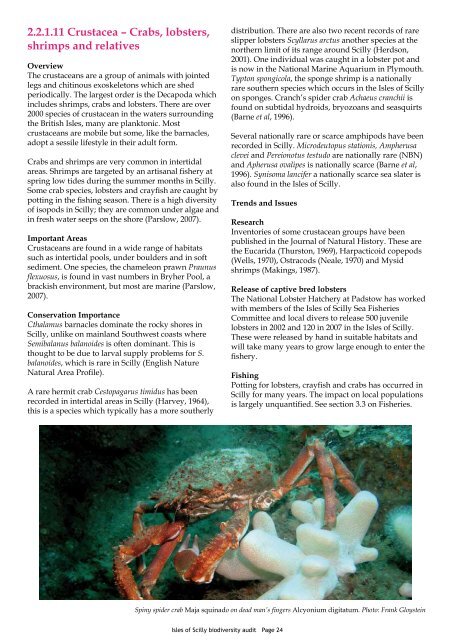The Isles of Scilly Biodiversity Audit 2008 - Cornwall Wildlife Trust
The Isles of Scilly Biodiversity Audit 2008 - Cornwall Wildlife Trust
The Isles of Scilly Biodiversity Audit 2008 - Cornwall Wildlife Trust
You also want an ePaper? Increase the reach of your titles
YUMPU automatically turns print PDFs into web optimized ePapers that Google loves.
2.2.1.11 Crustacea – Crabs, lobsters,shrimps and relativesOverview<strong>The</strong> crustaceans are a group <strong>of</strong> animals with jointedlegs and chitinous exoskeletons which are shedperiodically. <strong>The</strong> largest order is the Decapoda whichincludes shrimps, crabs and lobsters. <strong>The</strong>re are over2000 species <strong>of</strong> crustacean in the waters surroundingthe British <strong>Isles</strong>, many are planktonic. Mostcrustaceans are mobile but some, like the barnacles,adopt a sessile lifestyle in their adult form.Crabs and shrimps are very common in intertidalareas. Shrimps are targeted by an artisanal fishery atspring low tides during the summer months in <strong>Scilly</strong>.Some crab species, lobsters and crayfish are caught bypotting in the fishing season. <strong>The</strong>re is a high diversity<strong>of</strong> isopods in <strong>Scilly</strong>; they are common under algae andin fresh water seeps on the shore (Parslow, 2007).Important AreasCrustaceans are found in a wide range <strong>of</strong> habitatssuch as intertidal pools, under boulders and in s<strong>of</strong>tsediment. One species, the chameleon prawn Praunusflexuosus, is found in vast numbers in Bryher Pool, abrackish environment, but most are marine (Parslow,2007).Conservation ImportanceCthalamus barnacles dominate the rocky shores in<strong>Scilly</strong>, unlike on mainland Southwest coasts whereSemibalanus balanoides is <strong>of</strong>ten dominant. This isthought to be due to larval supply problems for S.balanoides, which is rare in <strong>Scilly</strong> (English NatureNatural Area Pr<strong>of</strong>ile).A rare hermit crab Cestopagarus timidus has beenrecorded in intertidal areas in <strong>Scilly</strong> (Harvey, 1964),this is a species which typically has a more southerlydistribution. <strong>The</strong>re are also two recent records <strong>of</strong> rareslipper lobsters Scyllarus arctus another species at thenorthern limit <strong>of</strong> its range around <strong>Scilly</strong> (Herdson,2001). One individual was caught in a lobster pot andis now in the National Marine Aquarium in Plymouth.Typton spongicola, the sponge shrimp is a nationallyrare southern species which occurs in the <strong>Isles</strong> <strong>of</strong> <strong>Scilly</strong>on sponges. Cranch’s spider crab Achaeus cranchii isfound on subtidal hydroids, bryozoans and seasquirts(Barne et al, 1996).Several nationally rare or scarce amphipods have beenrecorded in <strong>Scilly</strong>. Microdeutopus stationis, Ampherusaclevei and Pereionotus testudo are nationally rare (NBN)and Apherusa ovalipes is nationally scarce (Barne et al,1996). Synisoma lancifer a nationally scarce sea slater isalso found in the <strong>Isles</strong> <strong>of</strong> <strong>Scilly</strong>.Trends and IssuesResearchInventories <strong>of</strong> some crustacean groups have beenpublished in the Journal <strong>of</strong> Natural History. <strong>The</strong>se arethe Eucarida (Thurston, 1969), Harpacticoid copepods(Wells, 1970), Ostracods (Neale, 1970) and Mysidshrimps (Makings, 1987).Release <strong>of</strong> captive bred lobsters<strong>The</strong> National Lobster Hatchery at Padstow has workedwith members <strong>of</strong> the <strong>Isles</strong> <strong>of</strong> <strong>Scilly</strong> Sea FisheriesCommittee and local divers to release 500 juvenilelobsters in 2002 and 120 in 2007 in the <strong>Isles</strong> <strong>of</strong> <strong>Scilly</strong>.<strong>The</strong>se were released by hand in suitable habitats andwill take many years to grow large enough to enter thefishery.FishingPotting for lobsters, crayfish and crabs has occurred in<strong>Scilly</strong> for many years. <strong>The</strong> impact on local populationsis largely unquantified. See section 3.3 on Fisheries.Spiny spider crab Maja squinado on dead man’s fingers Alcyonium digitatum. Photo: Frank Gloystein<strong>Isles</strong> <strong>of</strong> <strong>Scilly</strong> biodiversity audit Page 24
















